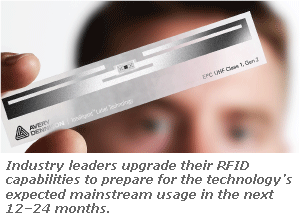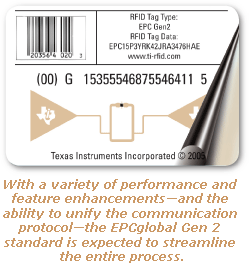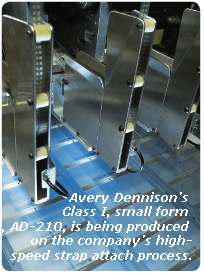RFID: The Next Generation
- Published: September 30, 2005, By Nsenga Byrd Thompson, Associate Editor
RFID Implementation
No matter what trade show, association meeting, or other industry event you attend, you won’t leave it without hearing something about radio frequency identification (RFID). Whether it’s smart packaging in the pharmaceutical industry, tagging at an airport or library, or implementation within the supply chain, you can’t escape the buzz surrounding RFID.
What does this ever-growing technology mean to converters? In this second of a three-part series, PFFC talks to the RFID industry’s leading players about the myths surrounding the technology, the reality, and how RFID implementation can affect your converting operation.
(Part III will appear in December as the continuation of the Ion Systems Technical Report, started in this issue. To view Part I, click here.)

RFID Mythology
With so much talk surrounding RFID, it’s hard to discern reality from legend. Industry experts agree there is still much to learn when it comes to RFID technology. Here’s the scoop on some of the lingering misperceptions.
Myth 1: The quality of the labels is poor.
Antony Sloan, manager of marketing and communications at Avery Dennison RFID, suggests that patience is needed as the industry works diligently to increase yields of successful tags. “These RFID labels look like labels we are all familiar with and have spent many years [producing] and have become experts at making, but the addition of the RFID inlay turns it into a pretty sophisticated communications device, and it’s a little unrealistic to expect that you’re going to get that right out of the box.”
Sloan continues, “Although RFID is not a new technology, it is a new application of this technology, so it shouldn’t be surprising that it takes a few months or even a couple of years to get it right.”
“It takes time to work out the kinks,” adds Igor Cerc, senior marketing manager for Avery Dennison RFID. “RFID in the UHF frequencies within the supply chain is new. It’s only two to four years old.”
Myth 2: Wal-Mart dictates everything.
When Wal-Mart’s mandate was issued back in late 2003, it was predicted that its top 100 suppliers would bend over backward for the retail juggernaut. And even though more than the 100 companies mandated have started implementation, the wheels didn’t turn quite the way people had first expected.
“[Consumer packaged goods] companies are taking Wal-Mart’s mandate seriously. However, they are choosing to implement it conservatively and carefully while waiting for the technology to advance and the new EPC standards to come to fruition,” says Sloan.
Myth 3: There is no return on investment in implementing RFID.
“ROI rarely just comes falling off a log,” says Matt Ream, senior manager for RFID at Zebra Technologies. “Usually you have to put a little work into engineering a system that’s going to be a little more efficient. If it was easy, everyone would be doing it…change is never easy, and it doesn’t happen overnight.”
He adds, “There are a large number of companies out there not involved in any of these compliance mandates that are implementing RFID and seeing great benefits with it.”
Enu Waktola, strategy supply chain manager for Texas Instruments, comments, “From the perspective of converters, there is a due diligence that is required. They have an even greater opportunity to get closer to their customers’ environments…. With RFID, you’ve opened up an opportunity for the converting industry where they can add a tremendous amount of value and services as well as basic capabilities.”
Ream compares the skepticism regarding ROI to the implementation of bar codes, which he reminds us took years to implement and started out as high as $.60 per bar code. “This is kind of déjà vu all over again. RFID is very much in the same boat right now [as bar codes were]. People don’t understand what the technology does. I think the biggest thing with RFID is if you’re going to extract all of the business benefits out of that technology to get ROI, you’re going to have to implement fundamental business process changes to get that value.”
Myth 4: The 5-cent tag is upon us.
Probably the most-heard industry buzz is the idea of the 5-cent tag. There has been much speculation that RFID can be mainstreamed at that cost. However, new discussion circulating around the industry is looking at this “dream tag” in more realistic terms.
According to Ream, waiting for the 5-cent tag to materialize soon is a misinformed expectation. “There is a lot of misunderstanding about the technology. The biggest [problem] is setting unrealistic expectations. RFID is not the Holy Grail, but it is a very good tool in your toolkit for a number of applications out there.

Growing Pains
Although many agree there are several bad rumors to dispel regarding supply chain RFID, there are still hurdles to overcome. Nearly two years ago, RFID tag yields were at a reported failure rate of almost 50%—a number that would make any label converter cringe. Two years is a long time in the world of RFID, and quality has improved. But with a failure rate still averaging 20%, work needs to be done to increase production yields.
“For a converter not experienced with the technology, saying that you’re going to throw away even 5 percent of what you’re producing sounds insane. So 20 to 40 percent really scares them off, ” says Cerc. “Everybody expected 2005 would be the year when huge volumes would be produced…and it hasn’t happened. So it becomes a little disheartening in the converting channels.”
Sloan agrees. “Some things have improved, but some things have not. The market demand has actually slowed down considerably, and it’s primarily caused by the shift to the Gen 2 standard. So what we see today is that Wal-Mart isn’t as strict with their mandate, which really means that not many companies (or end-users), are implementing or labeling a number of different SKUs.”
A New Generation
If you’ve been doing your homework, you’ve probably run across the term Generation or Gen 2 and its reported importance to mainstream RFID implementation. But is the idea of this high-performance standard just another industry misconception?

Cerc assures Gen 2 is the real deal. “Gen 2 essentially will make RFID technology better and will make it easier to use…. It eliminates confusion and eliminates investment in expensive equipment. It can handle difficult protocol and different standards and therefore streamline the whole process.”

Ream adds, “Class 0 and Class 1, while they may operate on the same frequency, really are two distinctly different protocols or languages. So in a truly open supply chain, if you have to deal with two different languages, it’s not real efficient. What Gen 2 is striving for is to come up with a unified communication protocol that is much better and is more globally accepted than either of the two previous standards. In addition, there’s a [variety] of performance and feature enhancements they threw in to make the system run better.”
“[Every component for implementation] isn’t where it should be for Gen 2, but by the end of the year, that should be resolved, and you should finally see Gen 2 taking hold,” advises Sloan. “From that point on, it probably will still take another six to 12 months for the entire market to embrace the technology and start making changes from Class 00 and 01 to Gen 2.”
The Million-Dollar Question
We’ve attempted to dispel a few RFID myths and bring you up to speed on the new generation of tags, so here’s the burning question: Is RFID right for your operation? The answer isn’t a simple one. Every converter operates under different circumstances. However, there are a number of converters that have begun full-steam RFID operations or at least are getting their feet wet in the technology.
With a minimum equipment investment of a half-million dollars (not including additional start-up costs), Ream urges converters to stay educated and really determine if the investment is right for them. “From a converter standpoint, there’s a pretty high-cost investment upfront in the technology, and I would say there’s a pretty good learning curve to get into the business.”
On the other hand, Waktola reports there are converting equipment suppliers giving road shows and educating CPCs around the country. She reiterates the attractiveness of the value-add that RFID can offer converters. “The sooner they get educated and start implementing RFID, the sooner they can reap the rewards of early implementation and having penetration of these new customers.
“Don’t wait. Start now, then progress,” encourages Waktola. “Start with testing. Get a reel of inlays. If you don’t have equipment, there’s a list of equipment providers that you can buy smart label insertion equipment from. Start coming up to speed on the learning curve. The sooner you start, the sooner you’re able to address your customers’ demands.”
No matter if you decide that now is the time to act or if staying informed currently is your operation’s best ammunition, RFID technology is continuing to evolve and grow and the converting industry is poised to grow with it.
SUPPLIER INFO:
Avery Dennison RFID—averydennison.com
Zebra Technologies—zebra.com
Texas Instruments—ti.com
Experiencing Technical Difficulties
There are several challenges in producing high quality RFID. Some of these problems exist even before the converter begins making the label (most notably, a defective inlay), but converters also find critical challenges in the production phase. The two most notable issues are with static electricity and testing of the labels.
According to Jay Perry, Simco Industrial Static Control, “Unfortunately, the involvement of RFID with packaging materials has changed everything because these tiny circuits cannot withstand exposure to stray voltages. They can experience damage from different sources. The most damaging is damage from a direct electrostatic discharge.”
Perry also comments on the problem with electromagnetic interference. “Equally dangerous for potential damage to RFID devices is EMI, which occurs when a device is exposed to a transient energy, or voltage temporarily overstressing the circuit and causing damage.”
Perry says there are static elimination products such as ionizers available to combat the problem. Igor Cerc of Avery Dennison adds that work is being done to the chip and inlay itself, so the label isn’t as susceptible to ESD during production.
Cerc also points out that faulty RFID labels can be identified during testing. “It’s one thing to test one tag in front of a reader. It’s another thing to test a product running through a press. It’s actually very difficult to test inlays at very high press speeds.”
He continues, “One of the challenges in the marketplace is to bring testing protocol and equipment up to snuff where everybody is testing against the same type of parameters and according to the same industry standard.”
Supplier Information:
Simco Industrial Static Control—simco.biz.com
This is part two of PFFC's three-part look at RFID. To read part one, click here.




